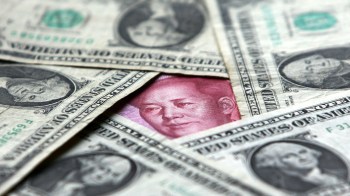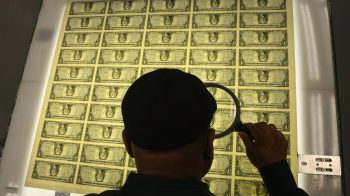U.S. winemakers toast to a strong euro
TEXT OF STORY
Kai Ryssdal: The beauty of covering business is that it’s not always a zero-sum game. There are clear winners and losers sometimes, but the news is usually more nuanced than that.
Currencies are a great example. As he was leaving this morning for a week in Europe, the president said official U.S. policy is to have a strong dollar. Of course, the dollar’s pretty weak now. It’s the euro that’s strong.
And as currencies move, exports rise, imports fall… or maybe it’s the other way around, depending on which side of the Atlantic you’re standing on.
Jeremy Hobson has the story now of an industry that’s feeling both the good and the bad.
Harvey Posert: We’re walking now in between Cabernet Sauvignon vines…
Jeremy Hobson: Harvey Posert is leading me through a vineyard, or as he likes to call it, his front yard.
Hobson: And with mountains on either side of us, I guess we are right in the heart of Napa Valley?
Posert: Exactly so. This is it. It’s 30 miles long and we’re about 10 miles from the bay.
Posert has been in the wine business for 50 years. These days, he represents the wines of the late Robert Mondavi and his two sons as well as those of Charles Shaw.
We get to talking about the weakening dollar and a smile comes across his face.
Hobson: What’s going on in the wine business?
Posert: Well, the wine business is good. Our exports have an advantage going overseas and imports are at a disadvantage coming in. So all signs are rosie… or rose as we say.
Especially, he says, because much of America’s main competition sells its wine in Euros. When the euro goes up, all those European wines get more expensive at the same time. But, things are not rose for everyone in the business. For some, they’re downright noir.
About an hour south of Napa, at the San Francisco Wine Trading Company, workers are boxing up champagne for delivery.
Employee Michelle Pepitone and owner Gary Marcaletti tell me European wines make up about 60 percent of their business and they’re getting more expensive by the day. That’s leading some customers to adjust their habits.
Michelle Pepitone: Say if they used to enjoy a Sancerre for $20 and now their favorite producer is $25, they’re going to look for a comparable producer in that same price range that they originally purchased.
Hobson: So they have their price point and they know what they want to spend, but they’re getting a different wine than they used to?
Pepitone: Yes, if the increase is significant.
In some cases, she says, that means a customer will drop that French Burgundy and go with a California Pinot. But in other cases, Marcaletti takes a smaller profit just to make a sale.
Gary Marcaletti: We’ve never seen this large of an increase over a period of say five years. We’re talking in some cases here about 75 percent increase in the dollar being so weak.
Marcaletti could easily drown his sorrows in a nice bottle of Bordeaux with a French winemaker. Last year, the French saw a three percent drop in exports to the world’s biggest wine customer, the United States.
Wine industry analyst John Fredrickson says France’s solution has been to allow the production of less expensive wine.
John Fredrickson: They’re also finding other markets. They’re aggressively going after big markets like the United Kingdom. Other new markets have emerged in Russia and in the Far East so that everybody is out selling wines where they can to offset the slowdown in the U.S.
Fredrickson says those producing cheaper American wines are the export winners here. Some even ship in bulk and bottle overseas to cut costs.
So I have to ask the big question: are we the new Argentina of wine?
Fredrickson: Well, not exactly. We’re up against countries that have huge surpluses and thus, they can be very competitive even against our best offer.
Plus, analysts warn, don’t pop the cork too soon. Just like in Argentina, a currency can rise just as fast as it can fall.
In Napa Valley, I’m Jeremy Hobson for Marketplace.
There’s a lot happening in the world. Through it all, Marketplace is here for you.
You rely on Marketplace to break down the world’s events and tell you how it affects you in a fact-based, approachable way. We rely on your financial support to keep making that possible.
Your donation today powers the independent journalism that you rely on. For just $5/month, you can help sustain Marketplace so we can keep reporting on the things that matter to you.


















